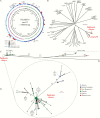Canada-Wide Epidemic of emm74 Group A Streptococcus Invasive Disease
- PMID: 29780850
- PMCID: PMC5952926
- DOI: 10.1093/ofid/ofy085
Canada-Wide Epidemic of emm74 Group A Streptococcus Invasive Disease
Abstract
Background: The number of invasive group A Streptococcus (iGAS) infections due to hitherto extremely rare type emm74 strains has increased in several Canadian provinces since late 2015. We hypothesized that the cases recorded in the different provinces are linked and caused by strains of an emm74 clone that recently emerged and expanded explosively.
Methods: We analyzed both active and passive surveillance data for iGAS infections and used whole-genome sequencing to investigate the phylogenetic relationships of the emm74 strains responsible for these invasive infections country-wide.
Results: Genome analysis showed that highly clonal emm74 strains, genetically different from emm74 organisms previously circulating in Canada, were responsible for a country-wide epidemic of >160 invasive disease cases. The emerging clone belonged to multilocus sequence typing ST120. The analysis also revealed dissemination patterns of emm74 subclonal lineages across Canadian provinces. Clinical data analysis indicated that the emm74 epidemic disproportionally affected middle-aged or older male individuals. Homelessness, alcohol abuse, and intravenous drug usage were significantly associated with invasive emm74 infections.
Conclusions: In a period of 20 months, an emm74 GAS clone emerged and rapidly spread across several Canadian provinces located more than 4500 km apart, causing invasive infections primarily among disadvantaged persons.
Keywords: Canada; emerging strain genotype; epidemic; group A Streptococcus; homeless; invasive disease; outbreak; populations at risk.
Figures



References
-
- Olsen RJ, Musser JM. Molecular pathogenesis of necrotizing fasciitis. Annu Rev Pathol 2010; 5:1–31. - PubMed
-
- Soderholm AT, Barnett TC, Sweet MJ, Walker MJ. Group A streptococcal pharyngitis: immune responses involved in bacterial clearance and GAS-associated immunopathologies. J Leukoc Biol. 2018; 103:193–213. - PubMed
Grants and funding
LinkOut - more resources
Full Text Sources
Other Literature Sources
Molecular Biology Databases

